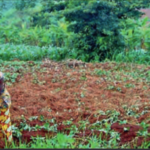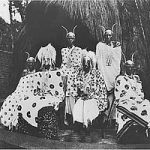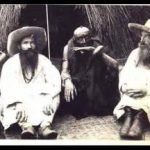European Settlers In Kinyaga And Kivu
Theestablishmentof European settlers in Kinyaga began during the 1920s. The largest employer during this period was the Protanag Company (Société Coloniale des Produits Tannants et Agricoles), a large undertaking whose staff incIuded nineteen Europeans in 1929. Protanag initially planted coffee, gradually introducing black walnut trees to be exploited for tannin. The company had received authorization to occupy 981 hectares (slightly over 2400 acres); by 1929 it had planted 480 hectares and was employing 1500 Kinyagans. Labor recruitment for Protanag was highly localized; in areas surrounding the company’s concessions (located in Impara chiefdom, near to Lusunyu and Kibazi in present Kamembe and Karengera communes, respec- tively), it was estimated that more than 80 percent of the available men
were employed. In addition to the Protanag operations, toward 1929 the Compagnie de la Rusizi began to introduce cotton in the Bugarama region of Kinyaga. There was also a Government-run model farm at Ntendezi and an industrial school at Kamembe.
While the European settler population in Kinyaga was still quite small during the 1920s, it was already developing rapidly in the Kivu province of the Congo (until 1933 a “district” of the larger Orientale Province). After World War I, Europeans in considerable numbers came to Kivu, setting up plantations of coffee, tea, and quinine, and later undertaking mining enterprises. In 1925 there were about 192 European settlers in Kivu; by 1929 the number had risen to some 943. These figures include all of Kivu, but a large proportion of the early Europeans settled near Lake Kivu. Demands for labor in the area increased so sharply between 1926 and 1929 that the colonial administration in Kivu “closed” several territories to recruitment. Kinyagans were recruited to supplement the insufficient labor force on the western side of the lake. As noted with some alarm in a missionary’s report of 1929,
New economic conditions, created by the establishment of large agricultural companies in the District (Cyangugu) and especially the proximity of numerous settlers in Kivu … are a real difficulty for our work… A lot of young people, for love of lucre or to flee the work requisitioned by the State, go to take on long term service. Christians often lose their morals if not their faith, the catechumens and pagans become indifferent to [Christian teachings].
The World Depression resulted in a general reduction in labor demands and a lowering of wages in Kivu, although agricultural expansion continued: the estimated amount of land planted in coffee in Kivu more than doubled during the period 1929-1936, increasing from 5528 to 11,655 hectares. After the Depression large-scale commercial agriculture and mining enterprises continued to expand in Kivu, and demands for labor increased as well. In 1935-1937 the European administration in Kivu again closed several territories to labor recruitment, advising European settlers and companies to seek workers outside those areas. In Kinyaga, the Depression arrested the activities of Protanag, but by 1939 there were some 11 European settlers with agicultural concessions and two agricultural companies in Cyangugu Territory, holding a total of about 1200 hectares. (From 1936 to 1953 Cyangugu included Rusenyi chiefdom, the area north of the Kilimbi River, which was formerly a part of Kibuye territory; therefore, these figures include European holdings in Rusenyi). In 1946, the number of Europeans holding agricultural concessions had risen to 35 and the area of their concessions to almost 2000 hectares. By 1948, some 50 Europeans held about 2500 hectares in Cyangugu Territory. Most of these concessions were located in Kinyaga, south of the Kilimbi River; they were particularly numerous in Cyesha chiefdom, where fertile soils suitable for coffee-growing and the ease of transport on the lake were important in attracting settlers. Gold mining activities opened in 1936 in northeast Kinyaga, in the Nyungwe forest, adding further to the demands for labor. These activities were supplemented during the 1940s by the development of smaller mining operations for extracting cassiterite and small-scale industrial undertakings such as brick factories.
https://uk.amateka.net/european-settlers-in-kinyaga-and-kivu/https://uk.amateka.net/wp-content/uploads/2020/08/lpld2.jpghttps://uk.amateka.net/wp-content/uploads/2020/08/lpld2-150x150.jpgModel CitizenshipTheestablishmentof European settlers in Kinyaga began during the 1920s. The largest employer during this period was the Protanag Company (Société Coloniale des Produits Tannants et Agricoles), a large undertaking whose staff incIuded nineteen Europeans in 1929. Protanag initially planted coffee, gradually introducing black walnut trees to be exploited for...BarataBarata rpierre@ikaze.netAdministratorAMATEKA | HISTORY OF RWANDA




